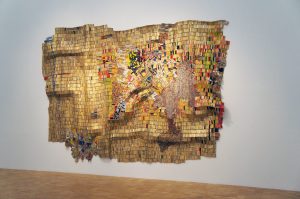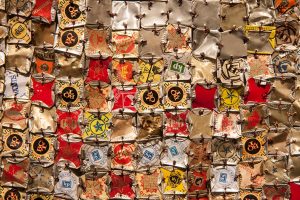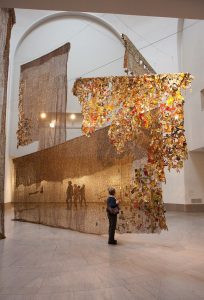Rachel Gerstenberger-Bottle Tops: Rejecting Colonialism and Embracing Cultural Identity
Introduction
El Anatsui, a Ghanian sculptor who lived out a great portion of his life in Nigeria, is famously known for his sculptures made with flattened bottle caps from liquor bottles found in Africa. Shown below are El Anatsui’s installations created with these flattened bottle caps, all of which represent that of a cloth. The art created by El Anatsui captures the attention of many, as Anatsui’s pieces greatly reflect his stance and experiences with colonization in Nigeria. His pieces, both conceptualized and created brilliantly, allow the viewer to reflect on what they define as “art” as well as the importance of cultural identity.

 “El Anatsui, Brooklyn Museum” by gsz is marked with CC BY-NC-ND 2.0.
“El Anatsui, Brooklyn Museum” by gsz is marked with CC BY-NC-ND 2.0.
 “El Anatsui, Brooklyn Museum” by gsz is marked with CC BY-NC-ND 2.0.
“El Anatsui, Brooklyn Museum” by gsz is marked with CC BY-NC-ND 2.0.
Themes
Two themes present in El Anatsui’s art are themes of challenging Western artistic standards as well as a theme of reclaiming African cultural identity. Western artistic standards have been continuously applied to artwork around the world, while invalidating the standards and conventions unique to non-Western cultures. This coincides with one’s cultural expression through the use of art, and therefore, places a very Eurocentric burden on African art and culture. With a rich history of colonization, erasure of cultural identity within a colonized state occurs naturally. This displacement of African culture is heavily reflected in Anatsui’s art as he navigates how the colonization of Nigeria and West Africa contributed to this erasure.
Analysis
These installations were created in West Africa during the 1960s: a critical point in African history as many African independence movements were occurring during this time period, these of which prompted El Anatsui to explore Africa’s rich history and culture.
A piece of significant context regarding Anatsui’s pieces surrounds his ethnic identity as part of the Ewe Nation, an ethnic group native to the West African region (particularly in Ghana and Nigeria). The Ewe people were victims of the trans-Atlantic slave trade–they were sold, traded, and raided, often to slave merchants within the European market. The Ewe nation, under the Berlin Conference, was subject to the rule of several different European nations throughout its colonial history, with power primarily resting in the hands of British, French, and German nations. The Ewe people wove what was called a “kente cloth” that was produced in West Africa, originating primarily in Ghana. This type of cloth and its significance to Anatsui’s culture inspired him to create his bottle top pieces with a resemblance to the kente cloth, which was woven by his father.
Cultural identity holds a great amount of importance to those in Africa. Especially in a colonial context, one’s cultural identity is such an integral factor of how one views themself. Cultural identities, particularly in Africa, are sacred and truly help people establish who they are within their cultural community. It is something people hold with pride and something people would do anything to protect. When another country attempts to exploit the social, political, and economic aspects of your community, your cultural identity is typically at risk. The erasure of an entire culture’s sense of identity, through the use of colonial forces and hegemonic practices, is an incredibly traumatic experience to go through. El Anatsui attempts to reclaim his African identity through his pieces by utilizing the liquor bottle tops in specific, as liquor was a primary export for European trade within both Ghana and Nigeria. Within all aspects of European trade with Africa, severe exploitation occurred that continuously put African economies and societies in jeopardy at the hands of European success. By using these bottle tops as his medium, Anatsui creates an art piece based off of the pain and suffering his people faced at the hands of European colonialism and exploitation. His piece represents his attempt to reclaim his African cultural identity that has been altered by European influences in West Africa.
The rejection of Western artistic standards is prominently displayed through El Anatsui’s pieces as well. The centering of Western standards for art allow pieces created by Anatsui to raise questions such as:
- Are Anatsui’s pieces considered to be an “art” or a “craft”? What are the differences between the two?
- Is an “art” considered to have a greater sense of sophistication than that of a “craft”? Why is this?
- Why is non-Western art often seen as “uncivilized”? What does this say about Western influence on artistic standards?
- How does the approach of distinguishing “art” from “craft” reflect topics such as class divide, hegemonic practices, and colonialism?
- What does referring to a cultural piece as a “craft” suggest about that person’s cultural identity?
- What gives an art piece value?
Anatsui challenges these notions by creating pieces that would typically be seen as a “craft” and therefore, less than, or less “sophisticated” than the high art praised by Western cultures. By creating the cloth using discarded liquor bottle caps and labels, Anatsui highlights the transformation of something seen as discarded (which could be represented by the Western notions of “discarding” the standards and ways of creating art by non-Western cultures) into a piece of art (something worth appreciation and respect, something that colonized cultures tend to desire from other parts of the world). By challenging Western artistic standards, Anatsui also challenges the grasp Western nations have on Africa and African culture.
Application
The pieces created by El Anatsui open the door to multiple incredibly different and important conversations to be held in regards to colonialism and Western influence within the context of West Africa. These discussions need to be held in order for us to gather a greater understanding of how West Africa, as well as many other parts of the world that share rather similar colonial experiences, was, and continues to be impacted by Western colonialism. Our society continues to place Western values on such a high pedestal that continues to erase and invalidate the different values other people may have across the globe. Anatsui’s approach of challenging Western artistic conventions inspires many others to reject what they have been told is the standard for what is considered “art” or what is considered “worthy” in the eyes of the West. His embracing and reclaiming of his African culture also opens the eyes of many to what many Africans experienced in regards to their own sense of self during the colonial period. While the colonial period seems to be “dated” and “many years ago,” Anatsui’s pieces look to emphasize that colonial ideas are embedded and reside within our system, and that they are built into our societal structure and can be written off as “normal” or “a sacrifice in the name of progress,” when they are anything but normal or acceptable.
Sources
Abiola Ola; A Textbook of West African History; 3rd edition; Ado-Ekiti; Omolayo Standard Press & Bookshops Co. (Nig.) Ltd.; 1984.
Binder, Lisa M. “El Anatsui: Transformations.” JSTOR, 2008, https://www.jstor.org/stable/20447883?seq=1.
Meyer, Birgit. “Christianity and the Ewe Nation: German Pietist Missionaries, Ewe …” JSTOR, 2002, https://www.jstor.org/stable/1581760.
Young, Allison. “El Anatsui, Old Man’s Cloth (Article).” Khan Academy, Khan Academy, https://www.khanacademy.org/humanities/ap-art-history/global-contemporary-apah/21st-century-apah/a/el-anatsui-old-mans-cloth.

